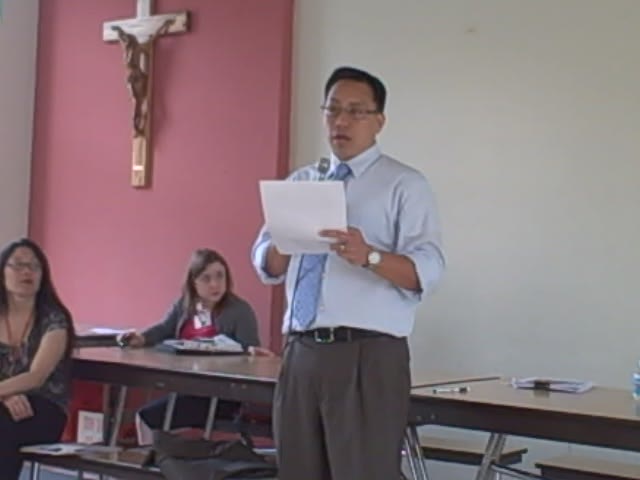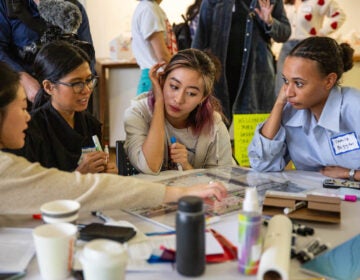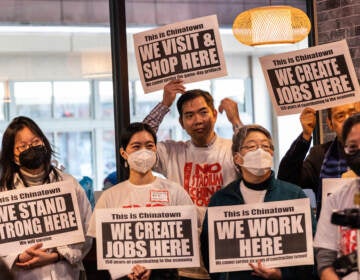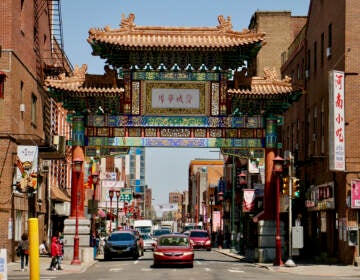Discussion of the future of Chinatown North

July 23, 2009
By Kellie Patrick Gates
For PlanPhilly
Residents of Chinatown North gathered at the Theresa Hu Center Wednesday night to talk about the future of their neighborhood – the part of Chinatown split off by the Vine Street Expressway.
Watch video
The discussion, sponsored by the Asian Arts Initiative and the Philadelphia Chinatown Development Corporation, hinged around a status report of the 2004 Neighborhood Plan for Chinatown and Callowhill, which was developed by the PCDC and John R. Gibbons, director of architecture for Kise Straw & Kolodner architects and planners after many months of community input. (KSK was hired by the Delaware Regional Planning Commission through a grant from the William Penn Foundation).
Based on the discussion last night, the community wants the same things it did then: Development that includes a significant amount of low-income housing. More green space and recreational opportunities for families. Education and help, including English language instruction, for immigrants. A wider variety of businesses. And oh, how they wish the Vine Street Expressway could be capped.
Some of the things outlined in the plan have happened, or soon will, said Gibbons and PCDC Executive Director John Chin.
Many trees have been planted through neighborhood streets since 2004, and Franklin Square has been revitalized into a recreation space utilized by neighborhood residents and many other people. Many new homes have been built – most of them at market rate. Even more are planned, Gibbons said, but work has been slowed by the economy.
Watch Video
This year, work will soon begin on a small park with green space, benches, and pergola at 10th and Vine. “The park idea came from the fact that families with young children were spending time there in the early evenings, just sitting on the wall,” Chin said. The $400,000 tab will be covered by a state Department of Conservation and Natural Resources grant and private donations, he said.
In March, improvements will start on 10th Street, from Race to Callowhill, to make it both more beautiful and safer, Chin said. This includes new sidewalks, lighting upgrades and more trees.. Also to help pedestrians, more on-street parking was added along Vine Street as a way to slow down traffic, he said.
Some key parts of the plan still lack funding. Chinatown has a dearth of city-owned recreational facilities, Chin said. The hope is to build a community center within the next five years, but money has to be found.
Another important element: Transforming the abandoned Reading Viaduct that crosses the neighborhood into a park, somewhat like New York City’s High Line Park. This is one of the pieces that took a lot of discussion prior to the 2004 plan. In fact, there is still some disagreement about how much of the viaduct should be kept, and how much should be demolished.
A Commerce Department study found it would cost about $5 million to turn the entire length into a bare-bones park and $35 million to completely dismantle it.
One attendee asked if the plan includes discussion on attracting clean industries to the area. It does not address specific types of industry, Chin said. But Laura Spina, the city’s Center City planner and discussion moderator, said that some businesses like this are already moving in, including The Red Cross and the Gift of Life. The Commerce Department is also doing a study of all industrial land in the city, she said. Commerce realizes that some of that zoning will need to be changed, Spina said. Some areas have been much more residential than industrial for many years, she said.
The Neighborhood Plan calls for removing a section of the Viaduct, and creating a grade-level park. Gibbons said the removal would help provide space for high-density development where there would otherwise be irregularly shaped building lots.
But Sarah McEneaney, vice president of the Callowhill Neighbors Association and a founder of an organization that is trying to save the Viaduct, said the irregular lots would just result in buildings with character, and the Viaduct could serve as a link between neighborhoods. McEneaney brought up the Commerce Department study, and said it would be much cheaper to keep the entire viaduct.
Andrew Toy, a board member of PCDC, said that demolishing the section from Vine to Green would cost significantly less than demolishing the whole thing – between $11 million and $13 million. He said it took a lot of time to come up with the compromise in the neighborhood plan, and he was concerned that continued disagreement could postpone movement on the project.
An often heated Chinatown topic – the proposed Foxwoods Casino – did not come up until close to the end of the three-hour session, when one man asked through an interpreter what impact the casino would have on the long-range neighborhood plan. Another man added that he hoped that Spina would lobby for the plan if the casino would have a negative impact on it when the City Planning Commission reviews Foxwoods’ proposal for Market and 8th.
Watch Video
“When this plan was done in 2004, we didn’t know Philadelphia would be getting casinos,” Spina said. When Foxwoods gives the Planning Commission its proposal, Spina said, things like traffic, parking, and social impacts will be considered. “But we don’t have anything yet,” she said. “We don’t have enough information now to make a determination, and I don’t know when we’re getting it.”
Another audience member, who said she is a doctor who worries a casino will tempt her patients into gambling problems, received a round of applause when she suggested that Chinatown should use the problems that could come with a casino as a bargaining chip to get the city to pay for more education and health services in their neighborhood.
Spina said that the city is “sensitive” to the increased needs for services that a casino would bring.
The PCDC and Asian Arts Initiative representatives said they hope to keep the discussion going with future events. Spina said residents should watch for a City Planning meeting sometime this fall. The City is creating a new comprehensive plan, she said, and will hold meetings around the city to hear what residents want in their neighborhoods.
Spina said the Comprehensive Plan will take neighborhood plans like Chinatown North’s into consideration, but that for the most part, the Comprehensive Plan will be a much more macroscopic view of where more transit, open space and housing is needed.
Contact the reporter at kelliespatrick@gmail.com
WHYY is your source for fact-based, in-depth journalism and information. As a nonprofit organization, we rely on financial support from readers like you. Please give today.






